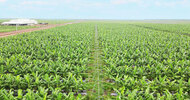 Christopher Metrakos, Senior Managing Director of Natural Resources for Ontario Teachers' Pension Plan
Christopher Metrakos, Senior Managing Director of Natural Resources for Ontario Teachers' Pension PlanOTTP | April 2024
Investing in Natural Resources can help to manage both climate and inflation risks
Christopher Metrakos, Senior Managing Director of Natural Resources for Ontario Teachers', explains how a focus on areas such as agriculture, metals, timberland and natural climate solutions helps the plan manage inflation risk and benefit from positive inflation exposure.
Inflation is an issue that has returned to the top of the agenda in the 2020s and it is one of the key risks that a defined benefit pension fund such as Ontario Teachers' must manage. At the same time, the challenges of climate change create new risks and opportunities for investors, including pension funds looking to provide long-term returns for their members.
In a recent story in IPE Real Assets, Christopher Metrakos, Senior Managing Director of Natural Resources, suggests one way to address climate change is to invest in natural resources. Below, read an expanded version of Christopher’s interview with the publication, including the role the industry plays in climate change and the opportunities Ontario Teachers’ sees to help grow its portfolio.
Tell us about Ontario Teachers’ Natural Resources portfolio.
Christopher Metrakos: Ontario Teachers' has a long history of owning timberland assets, but in 2013, we created a specific natural resources strategy. The diversified C$10 billion portfolio includes assets in oil and gas, metals, agriculture and aquaculture, timberland and natural climate solutions, with many of our investments giving us a controlling position.
When you’re investing in assets like metals, timberland or agriculture, taking control positions with the ability to influence operations means that we can support better direct engagement with local communities and influence environmental improvements. In our view, investing actively in this way is not only the right way to conduct business but will result in stronger performance over time.
Our portfolio now includes 130,000 acres of agricultural land globally, from apple orchards to row crop farmland and aquaculture assets, in Australia, Chile, Canada, the U.S. and Portugal. In timber, our two main assets are in New Zealand and the US.
In 2019 we acquired FirstFruits Farms LLC, a leading integrated apple business based in Washington State. We identified that strategically growing the production capacity of the business outside of Washington allows the business to provide local supply to retailers which is highly desirable. To that end we have acquired an apple producer in Michigan, giving FirstFruits Farms LLC nationwide supply.
We also invest in commodities. Our focus is on large, high-quality opportunities that offer growth over time, though we can do smaller opportunities through the platforms we have established in Chile and Australia. One of the plan’s successful investments in this area is the New Afton copper and gold mine located near Kamloops, British Columbia, which gives us exposure to gold and copper, which is an essential metal in the energy transition.
"By investing in private markets, the natural resources portfolio aims to both manage inflation risk and gain positive inflation exposure over the medium to long term, in a way that is not possible purely by investing in financial markets."
Why is Natural Resources a crucial part of the firm's long-term investing strategy?
CM: By investing in private markets, the natural resources portfolio aims to both manage inflation risk and gain positive inflation exposure over the medium to long term, in a way that is not possible purely by investing in financial markets.
For example, we purchase agricultural land rather than just buying a forward contract for a commodity such as wheat. By acquiring the land itself, we gain exposure to high quality agricultural assets in a way that offers superior risk-adjusted returns and allows us to be more active investors.
Since we don’t have required exit dates for investments, we can take a much longer-term view and look to move away from the crowds and capitalize on new areas.
How does climate change impact your strategy?
CM: As the impacts of climate change, in the form of extreme weather events from flooding to drought and wildfires, become more evident, issues such as climate, water and carbon emissions have become an increasingly important part of the due diligence process. We’re trying to build a diversified, geographic and robust portfolio that mitigates the impacts of weather and climate.
At the same time, issues around the Just Transition are also central to our investment decisions. Ensuring our portfolio companies operate in a socially responsible manner is crucial – we see it as less of a challenge and more of a red line, so it’s something we will not take a risk on.
Where do you see opportunities?
CM: We're optimistic about opportunities in agriculture, metals and environmental markets to grow our Natural Resources portfolio in ways that will promote improved environmental outcomes.
One area providing new opportunities for us is natural climate solutions where we're finding environmental markets businesses that allow us to engage with landowners on projects in carbon, biodiversity and water quality. Last year, we took a majority stake in GreenCollar, Australia’s leading environmental markets business. The company works with landowners to improve environmental outcomes and explain the need for such businesses to support global decarbonization efforts. GreenCollar has real depth of experience in this area, an exceptional track record and has been instrumental in leading the development of a market to support biodiversity in Australia. We expect to be investing through that business to promote improved environmental outcomes in Australia initially and later internationally.
In agriculture, we tend to like permanent crops that have strong water rights and are likely to be resilient to increasingly volatile climate environments. In metals, we’re looking to invest in industrial metals that will both support and benefit from the energy transition as well as starting to look at critical minerals and rare earths.
How do you manage inflation?
CM: Rather than relying solely on inflation-linked commodities, we realized that by investing in companies directly we can get exposure to good-quality agricultural assets in a way that offers superior risk-adjusted returns and where we can be more active investors. Our investments in oil and gas, metals, food, timberland and natural climate solutions create a diversified portfolio that helps us to manage inflation risk and even benefit from positive inflation exposure.













